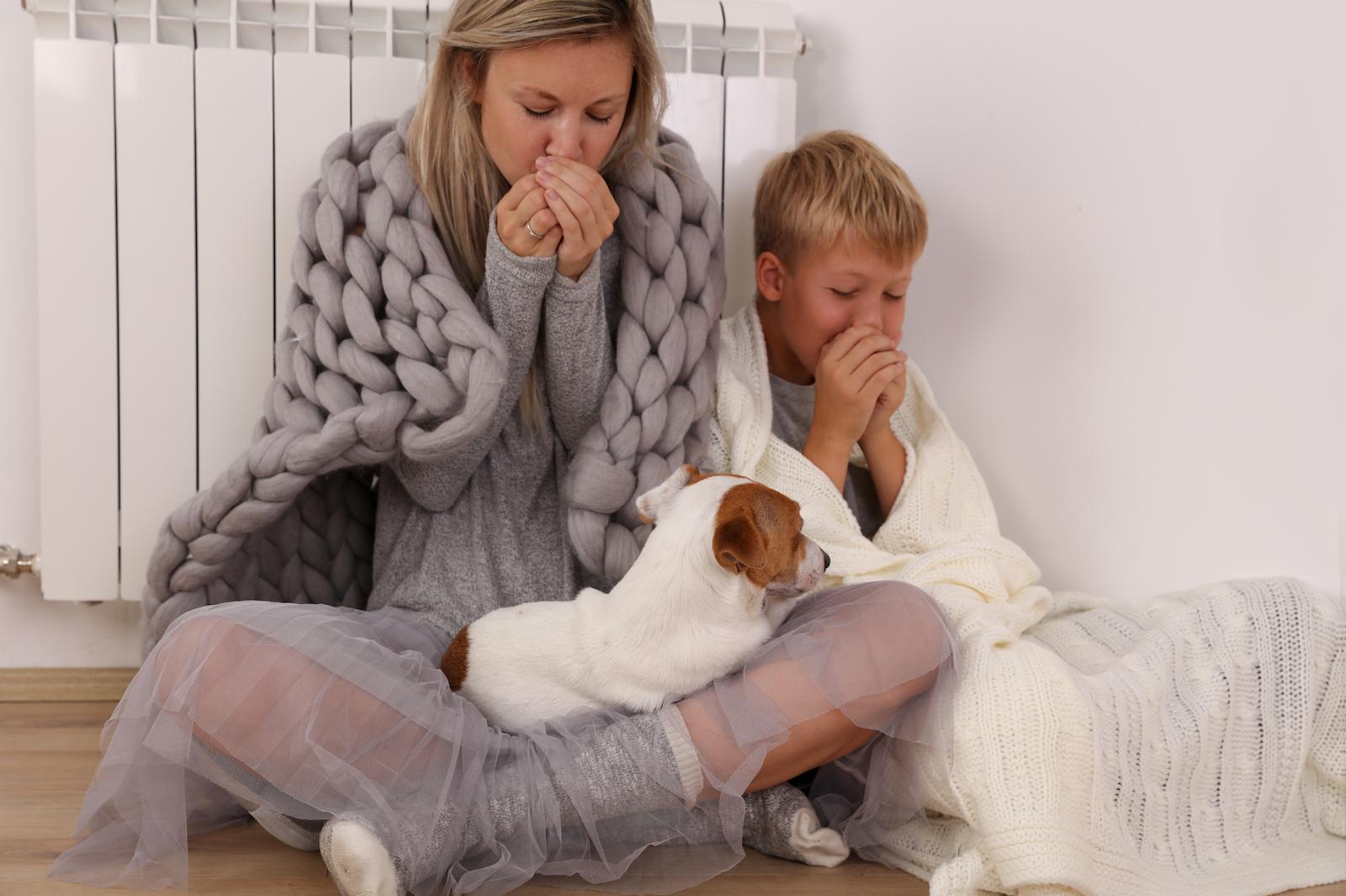Prepare for Winter Storms to Protect Your Home and Family
The words Winter Storm Warning can send a chill down your spine, whether you live in Pennsylvania, New York, Illinois, California or anywhere else prone to extreme winter weather. Learn how to prepare for a winter storm.
By Anne Fonda
Plunging temperatures from the polar vortex, freezing rain, ice, sleet, and heavy snow or rain can wreak havoc on your routine and your family’s comfort and safety. While the kids may be excited to sleep in and play in the snow, you have some work to do as a homeowner to get ready for the worst.
Why Winter Storm Preparation is Important
Being prepared for a winter storm can mean the difference between being comfy and cozy and suffering in the cold, or worse. Whether you’re preparing for heavy snow and frigid temperatures in Pittsburgh, Rochester, or Chicago, or you’re preparing for another atmospheric river in California or the Pacific Northwest, use some of the following ideas to protect your home and your family.
Winter Storm Watch vs Winter Storm Warning
Part of preparation means being informed – knowing the difference between a winter storm watch and a winter storm warning is a good place to start. The National Weather Service (NWS) has three levels of guidance that they issue: advisories, watches, and warnings.
Let’s take a look at what each of those means.
Winter Storm Advisory
Be Aware. An advisory is issued when conditions are right for a winter storm to form and cause trouble. Advisories are generally issued many days before a potential storm.
Winter Storm Watch
Be Prepared. A watch is issued when conditions look promising for heavy snow, sleet, or freezing rain to impact your county or region. This is the time to cancel or reschedule appointments and stock up on necessities in case a warning is issued.
Winter Storm Warning
Act Now. A warning is issued when heavy snow, sleet, or freezing rain is expected or imminent. Act immediately to protect your home and family. Stay inside and off the roads.
Which areas of the country are most affected by winter storms?
The NWS may also issue guidance for extreme cold, freezing rain, and flooding in the winter months. The basic idea is the same for each category. Winter storms can affect nearly all states, with the Mountain states, Midwest, and Northeast more likely to get snow, and southern states more likely to get freezing rain.
The Risks of Winter Storms
Winter storms and sudden cold snaps can be dangerous, and even deadly. If you don’t absolutely have to travel, stay home during a winter storm. According to the National Highway Administration (NHA), more than 900 people die each year and another 76,000 are injured in motor vehicle crashes during winter storms.
But while you’re safer at home, you and your family may still be in danger from other winter storm hazards, including:
- Hypothermia, frostbite
- Falling trees
- Power outages
- Heart attacks from shoveling
- Frozen pipes
- Flooding
- Mudslides
To protect your family and your home, take action before the next winter storm hits.
Prepare and Protect Your Outdoor HVAC Unit for Winter Storms
If it’s extremely cold, don your heavy winter coat, a hat, and gloves, and go outside to your outdoor unit. There are several things you need to do before, during, and after a winter storm.
- Clear vegetation and debris from around the outdoor unit. Your heat pump or air conditioning unit should always be free of obstructions that may block the flow of air. Keep the 18” around the unit clear.
- Clear snow from around a heat pump and clear the top. Winter snowstorms can result in heavy snow on top of and surrounding your heat pump. This will cause it to struggle to work. Make your way outside to clear off the top with a swipe of your arm or a broom.
Use your hands (with mittens or gloves on!) to clear an inch or two down the sides of the unit on all four sides. This will give you a clear view so that you can shovel away multiple feet of snow without nicking the unit. - With deep snow, make sure the furnace intake and exhaust pipes are clear of snow. You may not have paid much attention to them, but if you have a gas furnace, you have two pipes (typically white PVC) sticking out of your house near the area of your furnace. Make sure both pipes are clear of snow and ice.
A blocked exhaust pipe can allow deadly carbon monoxide gas to build up in your home. It’s odorless and colorless and is incredibly toxic. By the time you realize there’s a problem, one or more family members may be seriously ill. This is another good reason to make sure your carbon monoxide detector is working and has fresh batteries.
Trane furnaces have a safety feature that will shut your gas furnace off if the flue is blocked. So if your furnace stops working after heavy snow, go check to make sure the flue is clear. - You may also want to consider installing a protective cover. To protect your outdoor AC unit from snow, ice, and hail you may want to get a special cover. The Trane WeatherGuard™ unit helps keep leaves and debris out of your AC unit. In addition, it helps channel away rain and snow. You’ll need to remove the cover once you want to run the AC again.
Keep Cold Air Out and Warm Air In
Even though winter is well underway, it’s not too late to do some winterizing - especially if you can feel drafts. Many of these improvements can be DIY jobs, but you may want to hire a professional if you have a larger home.
You may be eligible for federal tax credits if you use qualified products to seal and upgrade your home insulation. It doesn’t matter which state you live in. Just be sure to keep a record and receipts for the products and services you use to increase your comfort and energy efficiency so that you have them for the next tax filing season.
These tax credits are separate but related to those available for replacing your HVAC system. If that’s something you’ve been thinking about, read our blog about the Inflation Reduction Act and how it can make a new HVAC system more affordable.
Some areas to address when it comes to sealing and insulating your home:
Garage Door Insulation
If you have an attached garage, adding or upgrading garage door insulation can make a huge difference in home comfort. It’s a pretty easy DIY job to replace the weatherstripping at the sides and bottom of the door. If you can see daylight coming in, you need to replace those pieces.
Google garage door installation and you’ll find all sorts of kits available at the big box stores and through Amazon. You’ll also see lots of how-to videos that can show you what you need to do. Before you buy anything, you’ll need to measure your garage door so that you get the right kit. You can reduce heat loss (or gain in the summer) with a foam board insulation kit that meets your needs and budget.
Attic Insulation
Insulating an attic can go a long way towards reducing heat loss during the winter months. Unless your home is new, chances are good that it doesn’t have enough insulation for today’s standards. There are several types of insulation for attics, and you’ll need to determine what works best for you. Loose-fill insulation and fiberglass batt insulation are the most common.
If you have a large attic with easy access, this might be a DIY job. Otherwise, think about hiring a pro who can assess your attic insulation needs and perform the work without falling through the ceiling below.
Window Insulation
Insulating windows may involve picking up a window insulation kit (or more than one). Google window insulation and you’ll again find all sorts of products and videos to help you with your project. Read the reviews to find the solution that will work best for your home and your skill set.
Before installing window installation film, ensure that your windows are fully shut and locked. Leaving windows unlocked during the winter lets cold air in - the last thing you need. An easy and attractive way to add window insulation is to have thicker curtains. You can open them during the day when the sun is shining, and close them at night to help keep cold air contained.
Door Insulation
Entry doors, patio doors, and interior doors that lead to the garage can be sources of cold air in the winter or hot air in the summer. Check for drafts and use weatherstripping to help maintain your home’s comfort.
For interior doors, you can also consider a draft stopper that slides under the door or lays on one side of it. These draft stoppers can match your home’s decor and can help keep cold air from the garage out of the kitchen or keep cold air from sinking down to the basement in the summer.
Sealing Air Leaks
Separately from adding garage door insulation, window insulation, or door insulation, you will want to seal any air leaks with caulk. If you have an older home, you may have a lot of issues with window and door frame gaps. Look for visible gaps and notice if you feel a draft around closed windows and doors.
Caulk any visible gaps yourself, or hire a contractor to do it.
The great news is not only will these measures help you keep your home warm in frigid temperatures, but they will also help keep your home cool during the hottest days of summer. Visit Energy Star for more sealing and insulating tips.
Protecting Outdoor Plumbing
If you live in an area where frigid temperatures in winter are not the norm, insulate any exposed pipes in your crawl space. You may also want to get hose bib covers or replace old outdoor faucets with frost-free hose bibs. You want to avoid having to deal with any frozen pipes.
Have Multiple Backup Plans in Case of a Power Outage
High winds, blizzard conditions, ice storms, and extreme stress on the grid in Texas in winter can all result in widespread power outages. Take steps now to prepare for the possibility your home loses power, perhaps for days.
- Consider getting a generator - portable now, or plan for a whole-house generator in the future.
- Stock up on firewood for a wood fireplace or wood stove.
- Have hand warmers, and extra blankets, and dress in layers if the power goes out.
- Be prepared to cook on an outdoor gas grill. (Make sure you have propane).
- Have plenty of extra batteries, flashlights, and matches for candles.
- Charge your phone(s) and remember you can use your car to charge it.
Winter storm preparedness can go a long way to increasing your peace of mind. By being prepared, you can weather the storm with a minimal amount of discomfort, and keep your family safe this winter.
Contact Your Local Trane Comfort Specialist
Winter storms can be dangerous. Don’t get left out in the cold, and prepare your home and your HVAC system for winter weather. While fall is an ideal time to get your furnace checked out, you can schedule it now if you missed the fall window for HVAC maintenance. You may also want to discuss if you need to upgrade your heat pump system to a dual fuel system.
Contact your local Trane Comfort Specialist to make sure your furnace or heat pump is operating at peak performance this winter. Many dealers offer emergency HVAC service 24/7. Stay warm, stay safe, and enjoy the winter season in comfort.
Anne Fonda, Content Writer
A Content Writer with Trane Technologies, Anne Fonda researches topics and writes for Trane® and associated residential HVAC brands. She works in collaboration with Trane Technologies subject matter experts, offering easy-to-understand, informative content on complex topics. Her goal is to help consumers make informed decisions on the products and services they need.
She has written for HVAC and other service provider websites for over 16 years. Before transitioning to web content writing, Anne had a 14-year stint as an award-winning journalist. She graduated cum laude from the University of Missouri-Columbia School of Journalism.
When she’s not working, Anne enjoys playing word games, reading, gardening, spending time with family, and visiting gardens and museums.




